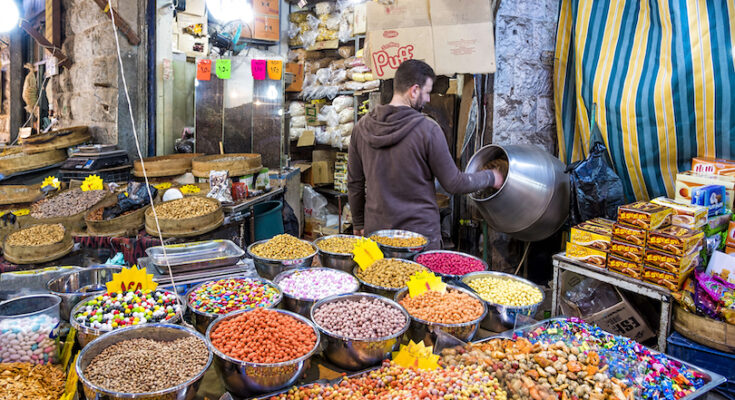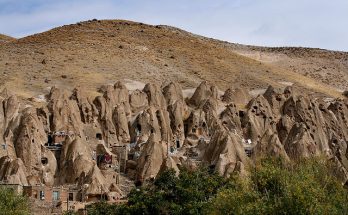Although most people head straight to Petra, the Dead Sea or all its Desert Castles, Jordan’s capital Amman has enough to keep you entertained for at least a few days. Besides age-old archaeological sites, it has traditional souks, top-class museums and trendy rooftop restaurants to check out.
One of the oldest continuously inhabited places on Earth, Amman is believed to have been settled at least 12,000 years ago. Its crumbling Citadel – one of its main attractions in Amman – attests to this as Roman, Byzantine and Umayyad ruins sprawl across its lofty hilltop. Not far away too is its ancient Roman Theater while Rainbow Street’s cool cafes and shops present a more modern side to the city.
One of the Middle East’s calmest capitals, Amman is a great base for exploring the rest of the desert nation. With lots of superb food and shopping options to try, there are certainly many things to do in Amman while the amazing Madaba and Jerash archaeological sites are located nearby.
Map of Things to do in Amman, Jordan
16. Cave of the Seven Sleepers
A fascinating place to visit, the Cave of the Seven Sleepers lies just twenty minutes drive southeast of downtown. Surrounded by a Byzantine cemetery, the important religious site has numerous myths swirling around it for you to uncover.
As legend has it, the ancient cave hid a group of young men who were fleeing religious persecution by Roman emperor Decius. God’s mercy saw them protected and the seven slept peacefully before miraculously emerging some 300 or so years later.
Although its exact location is still debated to this day, for many worshipers the one on the outskirts of town is a special spiritual place. Its weathered entrance, old rocks and carvings certainly look like they date to Biblical times as do the tombs inside. Asides from enjoying its age-old architecture and ambience, there are a couple of historic mosques to stop by here too.
15. Royal Tank Museum
The only museum in the Middle East of its kind, this rather recent addition to all of Amman’s attractions has tons of historic tanks, armored vehicles and military aircraft to inspect. Located in the northwest corner of King Abdullah II Park, it provides a captivating look at the country’s past battles.
Only opened in 2018, its extensive collection occupies an amazing building that looks very much like a stealth plane buried in the ground. In chronological order, its immense exhibition halls display over 140 tanks in dramatic settings. These hail from everywhere from Russia and Germany to the UK, the US and South Africa.
Very well-presented, they are fabulous to view and photograph with other pieces of equipment, arms and explanations lying alongside them. An absolute must for military aficionados, the museum really is an overlooked gem.
14. Nymphaeum

While the Citadel and Roman Theater understandably attract the most attention, the city also boasts plenty of other interesting archaeological sites. Right by them, for example, is the partially preserved Nymphaeum which is worth a quick stop when exploring the center.
Erected in the second-century AD, the ruins of the public fountain now only hint at their considerable size and splendor. Other than a paved plaza and a couple of still-standing columns, there are a few very worn carvings of human and animal figures to see.
In their heyday, Romans would both relax here and draw water from its three-metre deep pool. At its entrance, a useful image highlights what the once majestic fountain looked like in centuries gone by.
13. Darat al Funun
In contrast to the Roman-era ruins, Darat al Funun instead contains all kinds of cool contemporary artworks by Arab artists. Overlooking the historic heart of the capital, its pretty, peaceful complex lies just a short stroll from both the Citadel and Rainbow Street.
Nestled in the hills of Old Amman, its thought-provoking paintings, photos, sculptures and ceramics are displayed across six renovated historical buildings and warehouses. Since setting up in 1988, its foundation has supported countless up-and-coming local artists.
As always with Amman, ancient ruins are never far away. Besides elegant villas from the 1920s, its leafy grounds house the remains of a sixth-century Byzantine church. Old columns and a large cave can also be seen here. After taking in its arresting art and architecture, we really enjoyed sitting at its cafe and drinking in the phenomenal views over the city.
12. Jordan Archaeological Museum

If you want to delve even deeper still into the area’s ancient history, then the Jordan Archaeological Museum is definitely the place for you. Situated within the Citadel’s complex, its small building has a very unique collection of unusual artifacts to admire.
Founded in 1951, the museum presents thousands of fascinating archaeological findings unearthed all around Jordan. Arranged in chronological order from prehistoric times to the fifteenth-century are everything from preserved skulls and rhinoceros teeth to glittering jewellery and glass artworks.
The museum’s rare objects really are enthralling to examine with the astounding Ain Ghazal statues counting among its main highlights. These large-scale lime plaster and reed figures are remarkably some of the earliest uncovered representations of the human form.
While its displays do look dated, we’d still highly recommend going as you won’t find its millennia-old mosaics, sculptures and stone carvings anywhere else. You might as well anyway as entrance to the museum is included as part of your ticket to the Citadel!
11. Qasr al-Abd

For yet more age-old ruins, head to the crumbling Qasr al-Abd some forty minutes’ drive southwest of the center. Tucked away in a beautiful valley, the partially restored palace is thought to be the only Hellenistic structure still standing in the country.
Built out of sturdy stone blocks, the striking two-story house was constructed in the second-century BC. Originally surrounded by a moat, the ‘Castle of the Slave’ was probably intended to be a noble’s summer palace though was never actually completed.
Well off-the-beaten-path, its massive limestone blocks and faded carvings of lions and panthers are very interesting to see. Once opulent, its now ruined rooms make for some lovely photos, what with the resplendent nature all around them.
10. Day trip to Madaba

Even more impressive though are the magnificent Byzantine and Umayyard-era mosaics at Madaba. Lying forty-five minutes’ drive south of Amman along the King’s Highway, the ancient town and all its archaeological parks is just one of the nation’s many must-visit sites.
Scattered across the floors of countless houses and churches are lots of intricately-crafted mosaics for visitors to be amazed by. The most famous of these is definitely the ‘Madaba Map’ in the Basilica of Saint George. Made out of two million colourful pieces of stone, the sixth-century artwork depicts both Jerusalem and the Holy Land in astonishing detail. Yet more incredibly ancient mosaics can be seen in both the Madaba Archaeological Park and its on-site museum.
Many people also explore the extensive ruins of the Umm ar-Rasas Roman military camp and check out the 578 CE Church of the Apostles too. With so much to see and the popular Mount Nebo lying nearby too, the ‘City of Mosaics’ makes for a memorable day trip from the capital.
9. Try the Falafels

No trip to Amman and the Middle East can ever be complete without munching your way through all the tasty falafels you can find. Along with hummus, baba ganoush and fuul, the delicious deep-fried chickpea fritters count among the region’s best-loved dishes.
Normally served in a pita or as part of a mezze dish, sizzling hot falafel balls are often accompanied by fresh salads and pickled vegetables, all drizzled in hot sauces or tahini-based ones. Piles of chips and hummus doused in mouthwatering olive oil also sometimes come with the common street food.
While everyone has their favorite falafel joint, locals and tourists alike swear by the historic Hashem restaurant downtown. Another excellent option to try is Al Quds Falafel along Rainbow Street. One of our favorite things about traveling in the Middle East is its exquisite cuisine and Amman was no different. Almost everything we ate tasted incredible with small street stands often being just as good as chicer, sit-down restaurants.
8. King Abdullah Mosque

Certainly one of the city’s most eye-catching modern buildings is the colossal King Abdullah Mosque, just northwest of Al Balad. Capped by a marvelous blue mosaic dome and flanked by two majestic minarets, its staggering size, shape and colors make for some fine photos.
Only completed in 1989, the capital’s largest and most lavish mosque is dedicated to Abdullah I; the only Emir of Transjordan and the country’s first king. At any time, up to 7,000 worshipers may pray beneath its cavernous dome and glittering chandelier. Ornate panels and intricate-looking patterns decorate the walls of its massive main prayer room.
Often referred to as the Blue Mosque, it has engaging tours for non-believers to take and an Islamic museum to stop by. There is also a surprisingly good gift shop to pass through after having admired all its awe-inspiring architecture.
7. Al Balad

The oldest part of Amman, Al Balad is mostly home to bustling souks, beautiful buildings and many of the capital’s main attractions. With loads of local shops and restaurants to check out, its maze of narrow alleys really is intoxicating to explore.
Believed to have been inhabited since Neolithic times, the atmospheric neighborhood lies nestled amidst seven rolling hills. Dividing the area in two is the attractive Al Husseini Mosque with both the Citadel and Roman Theater located to the east of it.
As well as shopping for spices and souvenirs, you can stop for food or smoke shisha at its rooftop cafes. Despite the hustle and bustle, we found Old Amman had a surprisingly laidback feel to it. We really loved its energy and ambience and ended up spending most of our time in town ambling about Al Balad’s souks, shops and tourist sights.
6. Day trip to Jerash

Another great day trip you can do is to the remarkable ruins of Jerash, some forty-five minutes north of Amman. A must for history lovers, its endless site has tons of temples, plazas and theaters for you to wander around. Fittingly nicknamed the ‘Pompeii of the Middle East’, it certainly won’t disappoint with all that it has to offer up.
Impressively enough, the earliest ruins unearthed here date back to a scarcely believable 7,500 BC. The ancient city mostly thrived from the 1st to the 7th centuries under Roman rule. This explains the well-preserved Hadrian’s Arch, Hippodrome and Oval Forum we can still see today. Yet other highlights here include its Colonnaded Street and the South Theater’s stunning stage.
As the archaeological site is so vast, it is well worth taking a tour to best understand and appreciate the Greco-Roman city’s ancient history. Slowly strolling about the ruins, snapping photos of temples, streets and statues is sure to be a unique experience that will live long in the memory.
5. Rainbow Street
Back in the center of the city is one of its hippest spots to hit up: the vibrant Rainbow Street. Popular with locals and tourists alike, the steepish, sloping avenue is lined by loads of cool cafes, restaurants and rooftop bars. Some excellent art galleries and souvenir shops also border its pavements.
Winding its way up through the historic old Jabal Amman district, the famous thoroughfare is named after a former cinema. Hanging above parts of it are a myriad of multicolored lamps while other art decorations and murals also border some stretches.
While we went a couple of times, we didn’t really get the hype though there are certainly some nice cafes and bars to try. During the day, the street appeared almost deserted with most establishments seemingly catering mainly to tourists. Although it is maybe less authentic than all the colourful souks nearby, it is still worth heading here in the evening when there’s a livelier atmosphere.
4. Royal Automobile Museum

Home to all kinds of classic old vehicles, sleek motorbikes and flashy sports cars is the outstanding Royal Automobile Museum. Set alongside Al Hussein Public Parks in the very northwest of town, it is now one of Amman’s main attractions.
Established in 2003, its eighty or so cars mainly hail from the extensive private collection of the late King Hussein and the rest of the Hashemite royal family. Delightfully displayed in well-lit galleries, its earliest models impressively date to 1885 with informative plaques accompanying all of them.
On show are shiny cars of all colors with a 1952 Aston Martin and WWI-era armored Rolls Royce counting amongst its standout sights. Even if you’re not at all into cars, their unique designs are still quite cool to see. Some even feature in films like Tron, The Martian and Star Wars, all of which were partially shot in Jordan.
3. Jordan Museum

Offering a fascinating look at the country’s rich history, culture and heritage is the unmissable Jordan Museum. Located right next to City Hall, its sprawling complex covers prehistoric times right up until the present day.
Now the nation’s largest museum, its endless artifacts, artworks and archaeological findings were first unveiled to the public in 2014. While some galleries shine a light on Bedouin life and traditional rural communities, others present the kingdom’s founding in the forties and the multicultural make-up of the modern nation.
Of most interest, however, is its archaeological section which contains some of the Dead Sea Scrolls and the 9000-year-old Ain Ghazal statues. Besides ogling at ancient treasures, you can also learn all about the innumerable empires and civilizations that have called the area home over the millennia.
2. Roman Theater

Just a short walk away is the enormous Roman Theater which is yet another of Amman’s must-visit sites. Beautifully restored, its steep stairs and wide-open stage are amazing to explore with concerts and festivals still regularly held here.
Built into the side of a huge hill, the now iconic landmark was completed back in the second-century by the Romans. Looking out over Hashemite Plaza, its three tiers contain a considerable 6,000 seats with lovely views to be enjoyed from its higher realms.
Other than clambering up its sloping steps and gazing over the capital, you can watch modern plays and concerts here. There are also some museums and the much smaller Odeon Theater (also built by the Romans) to see nearby. A magnificent venue and historic sight, the Roman Theater is second only in Amman to the Citadel; its defining symbol and sight.
1. The Citadel

The crown jewel of what the city has to offer, the Citadel sprawls across the top of one of Amman’s highest hills. Now lying completely in ruins, exploring its immense archaeological site is the highlight of most visitors’ time in town.
Fortified as far back as 1800 BCE, the strategic hilltop has been occupied by many civilizations over the millennia. As such, its stone-strewn site encompasses not just the remains of the Roman Temple of Hercules but an Umayyad-era mosque, palace and market square too. The Citadel also has part of a Byzantine church to see and the Jordan Archaeological Museum to stop by.
From up high, you can also enjoy astonishing panoramas over the rest of the capital before you. We couldn’t get enough of its superb views and spent ages looking out over the Roman Theater and the gigantic Jordanian flag you see fluttering in the wind, far off in the distance.



